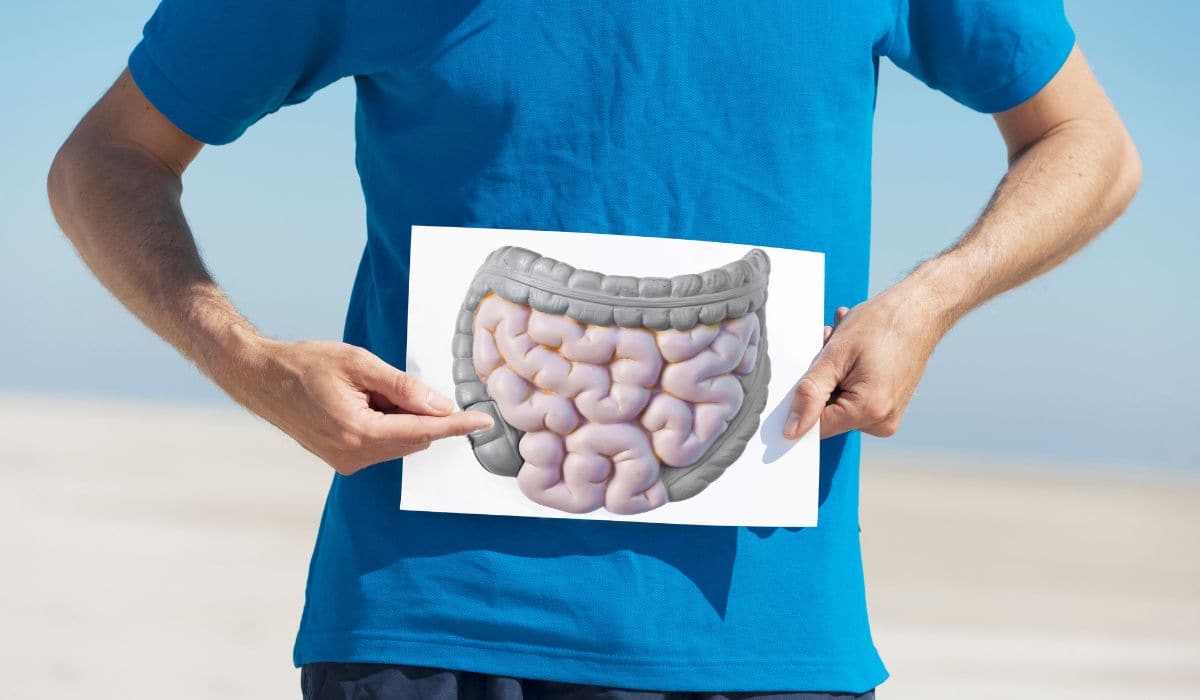
If you like metabolic health, absorbing nutrients from your food, good immune function, and staying at a healthy weight, then healthy gut function is a must. That includes the gut flora but also the lining of the gut and the permeability of the intestinal wall (how easy it is for stuff to cross from the intestine into your bloodstream).
But most people eating a modern diet have some kind of gut symptom(s), ranging from garden-variety constipation and diarrhea to symptoms that get an official name (Irritable Bowel Syndrome, functional constipation) to serious and even life-threatening diseases (Inflammatory Bowel Disease, Celiac Disease). One of the big goals of a Paleo diet is to heal the gut. It doesn’t seem like any of those problems should have anything to do with exercise, but actually, there’s a lot of evidence suggesting that physical activity can be part of healing from gut dysfunction, especially mind-body activities like yoga. Here’s a look.
Exercise, Inflammation, and Gut Disease
One way that exercise can help with all kinds of gut-healing projects is by modifying inflammation. Inflammation in the gut is a huge part of two important gut disorders: Irritable Bowel Syndrome (IBS) and Inflammatory Bowel Disease (IBD, including both ulcerative colitis and Crohn’s disease).
Both IBS and IBD involve inflammation in the gut. Exercise is inflammatory in the short term, but it’s a powerful anti-inflammatory in the long run, so it’s completely reasonable to guess that it might be helpful. And it turns out we can do better than guess: several studies have pointed to the benefits.
This study looked at the ways that exercise might be useful for Inflammatory Bowel Disease by reducing inflammatory damage to the gut. When the researchers looked at populations over time, low physical activity was associated with IBD. The more active people were, the less likely they were to develop IBD over the course of their life. That’s an association and it doesn’t prove a causal relationship, but other studies also showed benefits for exercise interventions (more on that below).
The researchers also had an explanation for specifically how the anti-inflammatory benefits work. Patients with Crohn’s Disease have unusual amounts of fat around the parts of their gut that are inflamed. The fat produces inflammatory cytokines, which contribute to intestinal inflammation. Muscle contractions release anti-inflammatory myokines, which may help combat the proinflammatory signals from the fat tissue. (Note that this doesn’t depend on the exercise causing any weight loss)
It Only Works if it’s Not Stressful
One last interesting point about this review actually comes from some of the mice studies that the authors looked at. If the researchers forced the mice to run on the treadmill, they got worse symptoms and increased inflammations. But if the researchers let the mice run on their own time, they had lower inflammation and were protected against intestinal damage. In other words, if the exercise itself was a stressor, it didn’t do anything to help with the IBD symptoms and actually made them worse. But it helped a lot when it was voluntary (so presumably what the mice wanted to be doing, since mice aren’t known for their ability to guilt-trip themselves into running on treadmills).
The lesson here: don’t turn exercise into yet another stressor. It shouldn’t be something you hate or have to force yourself through; it’s actually less beneficial (and maybe even harmful) that way.
Other Potential Benefits for IBS and Symptom Relief
There are also a handful of other reasons why exercise might be helpful for Irritable Bowel Syndrome and general GI symptoms like constipation and gas.
This study found that a 12-week exercise intervention helped reduce symptoms of Irritable Bowel Syndrome, suggesting that the exercise helped improve the passage of food through the gastrointestinal tract and decrease symptoms of bloating. The author also proposed that it might be the psychological stress relief of exercise: stress is a well-known IBS trigger, so the stress management benefits might have helped with the IBS symptoms.
Don’t Forget the Gut Flora

Of course, the all-important gut flora come out to play again here – gut flora are involved in IBS and IBD, as well as symptoms that don't get an official diagnosis like constipation and diarrhea. Exercise modifies the gut flora, and may help preserve the diversity of the microbiome under stress (that’s good: diversity is a good thing, and higher diversity is associated with protection against obesity).
Yoga and Mind-Body Exercise
One particular type of exercise with benefits for gut problems is yoga. That makes perfect sense, since yoga is a mind-body practice, and a lot of gut disorders have a mental component (most famously, antidepressants are a reasonably effective treatment for Irritable Bowel Syndrome). Here's a look at some studies that found particular benefits from yoga for IBS and IBD.
This study looked at 100 patients: 60 with ulcerative colitis and 40 with Crohn’s Disease. Half of the patients got yoga classes on top of their usual medical therapy: 1 hour a day for the first week, and regular follow-up visits at home for the next 7 weeks. The yoga therapy included both asanas (postural and “stretching”-type exercises) and pranayama (breathing exercises). In the yoga group, patients with Ulcerative Colitis saw significant reductions in anxiety and pain, even though they didn’t have any significant changes in immune function or other biologically measurable markers.
The study also cited previous work showing that other mind-body therapies and relaxation training improved symptoms of Inflammatory Bowel Disease
This study found that an Iyengar yoga program was effective for reducing severity of Irritable Bowel Syndrome (IBS, not the same as IBD). Iyengar yoga is a type of yoga that focuses on physical alignment and postural control. The researchers found that yoga reduced the sensitivity of the intestine to pain and improved the overall IBS symptom scores. Interestingly, the same study found that walking also improved overall GI symptoms, anxiety, and mood - the overall improvement was significant in both the yoga and the walking groups, but the two interventions improved different symptoms. And when they asked the participants to self-regulate their exercise practice, the people were more likely to stick to walking than they were to stick to yoga.
This study found that a specially-designed children’s yoga program was effective for IBS and abdominal pain in children age 8-18. This study looked specifically at teenagers (age 14-17) and young adults (18-26) with IBS, and also used Iyengar yoga. The intervention group got an hour and a half of yoga twice a week for six weeks. The yoga significantly improved symptoms in the young adult group (although interestingly, it wasn’t nearly as useful for the teenagers). Symptoms came back when the yoga intervention ended. So in other words, yoga works as long as you do it, and when you stop doing it, it stops working. No real surprises there.
Summing it Up
There’s actually a reasonable amount of evidence that gentle, non-stressful exercise is therapeutic even for serious gut diseases. Yoga in particular has been studied for IBS and IBD, and it seems to have a significant benefit as long as the participants keep it up. A few reviews have suggested that this is thanks to the anti-inflammatory benefits of regular exercise, but exercise could also work by modifying gut flora composition or by a combination of several different mechanisms. Regardless, there's evidence that it helps, and it's hard to see how it could possibly hurt.





Leave a Reply